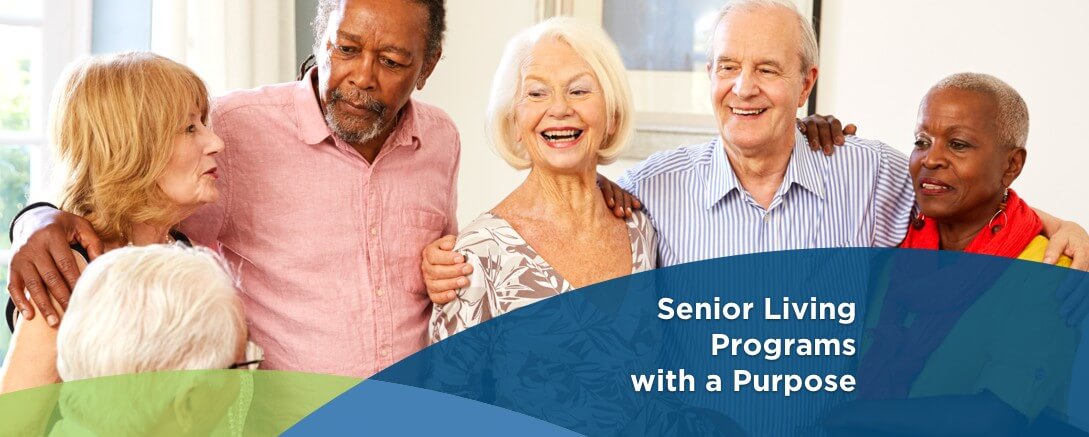What Programs are Included in a Senior Living Activity Calendar

How to Evaluate a Senior Living Activity Calendar
One of the keys to senior wellbeing is active and varied activities that combine recreation with intellectual challenges. However, not all senior living programming considers this fact — and seniors often don’t get the physical and mental stimulation they need for health and wellness.
To learn how to evaluate a community’s senior living programming — in particular, the activity calendar — read the insights from our senior living specialists below.
3 Types of Senior Living Programming
When exploring a senior living, it’s important to understand the various types of programs that cater to your loved one’s needs. Here are the three main categories into which signature senior living programming generally falls:
Evidence-based programs
When considering physical activities in senior living, ask about evidence-based exercise programs, as well as appropriate training of the associates leading the programs. For example, the exercise program at Benchmark communities was designed by an arthritis foundation and implemented to help all residents increase joint flexibility, boost the range of motion, and maintain muscle strength.
Themed programs
Themed programs are a fun, purposeful way to keep residents engaged in community life. In 2017, for example, we learned about communities “Traveling the United States.” On their cross-country road trips, residents “visited” a different state each month to get a bird’s-eye view of different landmarks, traditions, and foods.
Design-your-own programs
The best senior living communities will customize programs to meet the needs of individual residents. Through Benchmark’s “Dream Now” program, for instance, residents share their bucket-list wishes, and the community helps make those plans and intentions come true. By building relationships with residents, associates can even anticipate wishes and coordinate outings accordingly.
Learning about the purpose of community programs helps to gain a clear picture of the community’s priorities and ways in which your loved one can thrive in that setting. What makes programming especially innovative?
According to Rachel Francine, the most innovative companies do the following:
- Commit resources (both people and funds) to innovation so that programs are piloted in a way that allows for proper evaluation by the provider’s decision-making team and includes the identification of goals and benchmarks that signify success.
- Ensure that innovation teams have the internal juice they need to get good programs adopted across the communities that would benefit from the piloted program.
- Commit resources not only to piloting the roll-out of programming, but also its continued monitoring.
Senior Living Activity Calendar: Senior Living Programs with a Purpose
Now that you understand the various types of senior living programming and what makes the best ones, it’s time to look at how senior living programs are structured. Why is your activity calendar structured, the way it is? What is the underlying purpose?
Why it matters: All programs should have a purpose—and that purpose shouldn’t just be to pass the time.
At Benchmark communities, for example, all programs are designed to engage residents in the six dimensions of wellness promoted by The National Wellness Institute: intellectual, social, physical, emotional, sense of purpose, and spiritual.
- Intellectual and social experiences may include concerts, book discussions, cultural programs, food demonstrations, educational seminars, and more.
- Physical programming may include fitness classes, strength and balance programs, creative movement, yoga, and walking clubs.
- Programs that generate a sense of purpose may include community service projects, cooking, gardening, providing companionship or assistance to a neighboring resident, and assisting with event planning.
- To promote spiritual wellness, senior living communities discuss inspirational quotes, words of wisdom and may offer religious services for a variety of faith backgrounds.
During a virtual or physical tour, be sure to request a copy of the community’s calendar to review the types of programs available, in order to match individual interests and abilities to the activities scheduled.
Questions to Ask to Evaluate a Senior Living Activity Calendar
 Rachel Francine of Musical Health Technologies offers the following guiding questions to evaluate programming when considering communities for Mom or Dad: 1) Are residents getting enough exercise both physically and neurologically, to maintain good health? 2) Will residents be able to connect with friends who have similar interests? 3) Are there events that will attract residents’ families to come to visit, with the goals of creating positive lifelong memories for children and grandchildren — and the best possible life for residents?
Rachel Francine of Musical Health Technologies offers the following guiding questions to evaluate programming when considering communities for Mom or Dad: 1) Are residents getting enough exercise both physically and neurologically, to maintain good health? 2) Will residents be able to connect with friends who have similar interests? 3) Are there events that will attract residents’ families to come to visit, with the goals of creating positive lifelong memories for children and grandchildren — and the best possible life for residents?
Francine also believes in the following best practices when it comes to implementing high-quality programming in senior living communities:
- If consistent, quality, therapeutic results are desired then there needs to be a commitment to offering the programming several times per week.
- Memory care programming should be person-centered and focused on the arts and sensory/tactile therapies.
Best Practices in Terms of “What’s Best for Mom”
 Colin Milner, CEO/Founder, International Council on Active Aging (ICAA) reminds families to also think about best practices in terms of “what’s best for Mom” or whoever is considering senior living.
Colin Milner, CEO/Founder, International Council on Active Aging (ICAA) reminds families to also think about best practices in terms of “what’s best for Mom” or whoever is considering senior living.
He also suggests asking whether specific practices or programs can be customized to meet or exceed a loved one’s individual needs, wants aspirations, and expectations. For example, certain exercise classes may be below your dad’s physical capabilities.
“If these classes do not challenge him, his results could be reduced, making it difficult to achieve his goals,” says Milner. “Be sure the evidence is supported by the personalization of the programs: that’s [truly] a best practice,” he adds.
By asking the questions above and measuring programs at prospective communities with these best practice principles, families can make a more informed, more empowered decision for senior family members.


